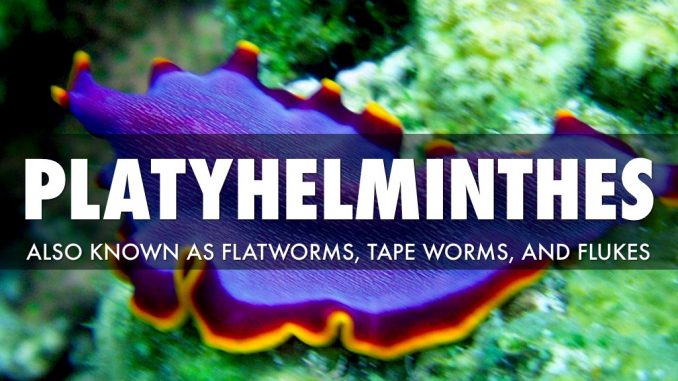
General characteristics of phylum Platyhelminthes
- (Platys: flat; helminthes: worms)
- Kingdom: Animalia
- Habitat: mostly parasitic, few are free living in sea water or fresh water
- Grade of organization: Organ- system grade of organization
- Symmetry: Bilateral symmetry and Body is dorso-ventrally flattened
- Germ layer: Triploblastic. Ectoderm is very specialized with distinct epidermis
- Coelom: Absent (acoelomate).
- Digestive system: incomplete or absent
- No mouth (oral opening directly into pharynx).
- No true stomach structure (pharynx opens into a complex “intestinal” structure).
- In tapeworms, Direct absorption of soluble nutrients by cells and tissues.
- Excretory system: Protonephridia with Flame cell
- Respiration: by simple diffusion of gases through body surface
- Circulatory system: Absent
- Reproduction
- Sexual: by gamatic fusion in hermaphrodite species
- Asexual : by regeneration and fission
- Fertilization: internal.
- Life cycle is complex involving one or more hosts.
Classification of Phylum Platyhelminthes
Phylum Platyhelminthes is divided into three classes on the basis of body shape, mouth position and habitat
Class 1 Turbellaria
- Mostly Free-living fresh water organism
- Body: dorsoventrally flattened
- Hooks and sucker usually absent
- Examples: Planaria, Bipalium, Otoplana, Notoplana
Class 2 Trematoda
- Mostly parasitic
- Body: dorso-ventrally flattened leaf like
- Hooks and sucker are present
- Examples; Fasciola hepatica (Liverfluke), Diplozoon,
Class 3 Cestoda
- Exclusive parasitic
- Body: dorso-ventrally flattened tape like
- Hooks and sucker are present
- Digestive system-absent
- Excretion: Protonephridia with flame cell
- Examples: Taenia spp ( tapeworm), Convoluta, Echinobothrium
